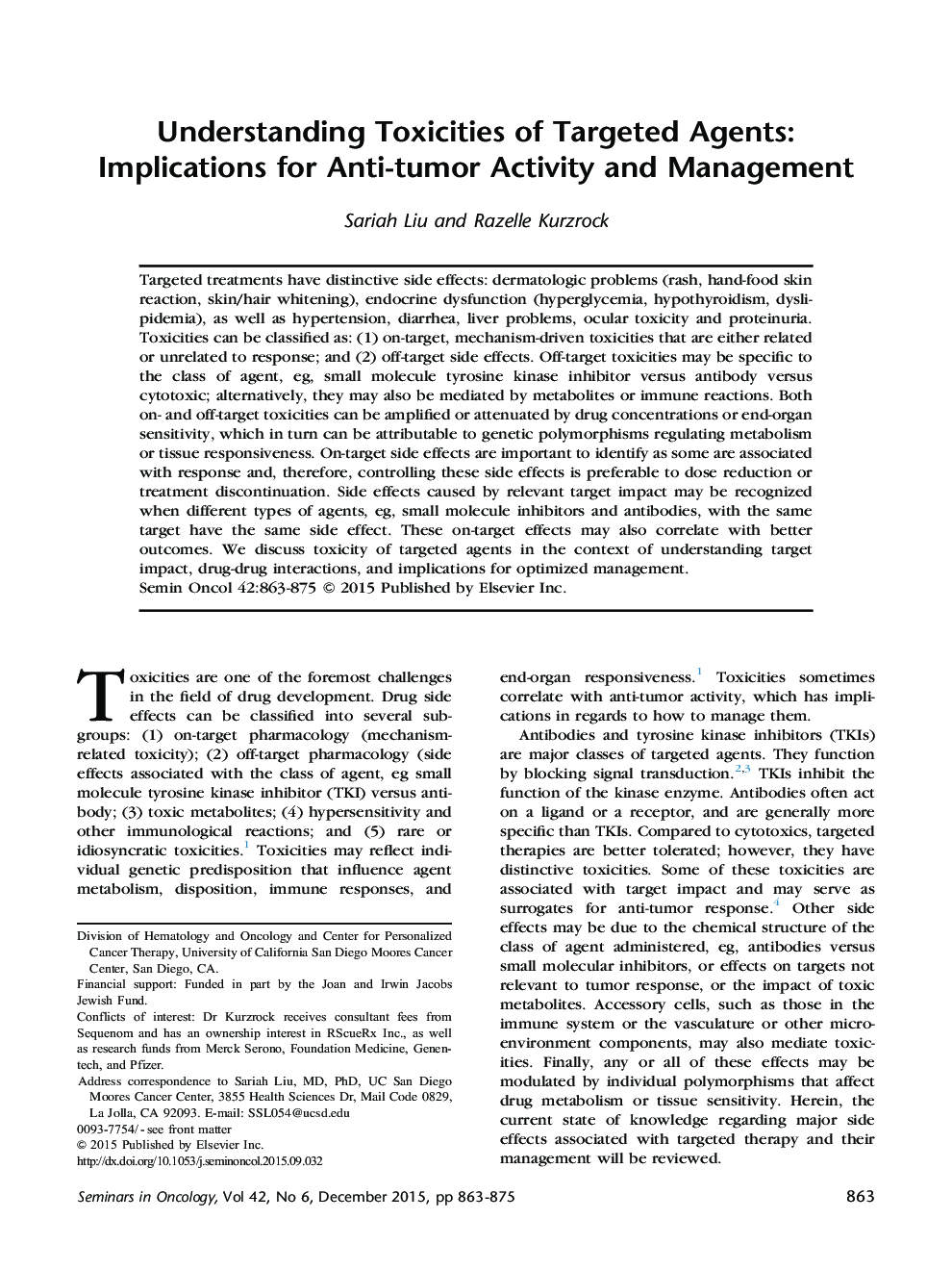| کد مقاله | کد نشریه | سال انتشار | مقاله انگلیسی | نسخه تمام متن |
|---|---|---|---|---|
| 10924317 | 1091211 | 2015 | 13 صفحه PDF | دانلود رایگان |
عنوان انگلیسی مقاله ISI
Understanding Toxicities of Targeted Agents: Implications for Anti-tumor Activity and Management
ترجمه فارسی عنوان
درک مسمومیت های عوامل هدفمند: تاثیرات در فعالیت های ضد تومور و مدیریت
دانلود مقاله + سفارش ترجمه
دانلود مقاله ISI انگلیسی
رایگان برای ایرانیان
ترجمه چکیده
درمان های هدفمند دارای عوارض جانبی متفاوتی هستند: مشکلات پوستی (بثورات پوستی، واکنش پوستی دست و پا، سفید شدن پوست / مو)، اختلال غدد درون ریز (هیپرگلیسمی، هیپوتیروئیدی، دیس لپیدمی) و همچنین فشار خون بالا، اسهال، مشکلات کبدی، سمیت چشم و پروتئینوری. سمیت بودن را می توان به صورت زیر تقسیم کرد: (1) سمیت های هدفمند و مکانیزمی که با واکنش مرتبط یا غیر مرتبط هستند؛ و (2) عوارض جانبی غیر هدف. سمیت های غیر هدف ممکن است برای کلاس عامل خاص باشد، مثلا مهارکننده تریسترویین کیناز مولکول کوچک در مقایسه با آنتی بادی در مقایسه با سیتوتوکسیک؛ به طور متناوب، آنها همچنین می توانند توسط متابولیت ها یا واکنش های ایمنی متمرکز شوند. هر دو سموم درون و خارج از هدف می تواند توسط غلظت دارو یا حساسیت انتهای اندام تقویت شده یا تضعیف شود، که به نوبه خود می تواند به پلی مورفیسم ژنتیکی تنظیم کننده متابولیسم یا پاسخ بافت بستگی دارد. عوارض جانبی بر روی هدف برای شناسایی بعضی از آنها با واکنش ارتباط دارد و بنابراین کنترل این عوارض جانبی برای کاهش دوز و یا قطع درمان بهتر است. عوارض جانبی ناشی از تاثیر هدف مورد نظر ممکن است شناسایی شود، زمانی که انواع مختلف عوامل مانند مهار کننده های مولکولی کوچک و آنتی بادی ها با یک هدف مشابه اثر مشابهی دارند. این اثرات بر روی هدف نیز ممکن است با نتایج بهتر مرتبط باشد. ما در مورد سمیت عوامل هدفمند در زمینه درک تاثیر هدف، تعاملات دارویی و داروها و پیامدهای مدیریت بهینه بحث می کنیم.
موضوعات مرتبط
علوم زیستی و بیوفناوری
بیوشیمی، ژنتیک و زیست شناسی مولکولی
تحقیقات سرطان
چکیده انگلیسی
Targeted treatments have distinctive side effects: dermatologic problems (rash, hand-food skin reaction, skin/hair whitening), endocrine dysfunction (hyperglycemia, hypothyroidism, dyslipidemia), as well as hypertension, diarrhea, liver problems, ocular toxicity and proteinuria. Toxicities can be classified as: (1) on-target, mechanism-driven toxicities that are either related or unrelated to response; and (2) off-target side effects. Off-target toxicities may be specific to the class of agent, eg, small molecule tyrosine kinase inhibitor versus antibody versus cytotoxic; alternatively, they may also be mediated by metabolites or immune reactions. Both on- and off-target toxicities can be amplified or attenuated by drug concentrations or end-organ sensitivity, which in turn can be attributable to genetic polymorphisms regulating metabolism or tissue responsiveness. On-target side effects are important to identify as some are associated with response and, therefore, controlling these side effects is preferable to dose reduction or treatment discontinuation. Side effects caused by relevant target impact may be recognized when different types of agents, eg, small molecule inhibitors and antibodies, with the same target have the same side effect. These on-target effects may also correlate with better outcomes. We discuss toxicity of targeted agents in the context of understanding target impact, drug-drug interactions, and implications for optimized management.
ناشر
Database: Elsevier - ScienceDirect (ساینس دایرکت)
Journal: Seminars in Oncology - Volume 42, Issue 6, December 2015, Pages 863-875
Journal: Seminars in Oncology - Volume 42, Issue 6, December 2015, Pages 863-875
نویسندگان
Sariah Liu, Razelle Kurzrock,
